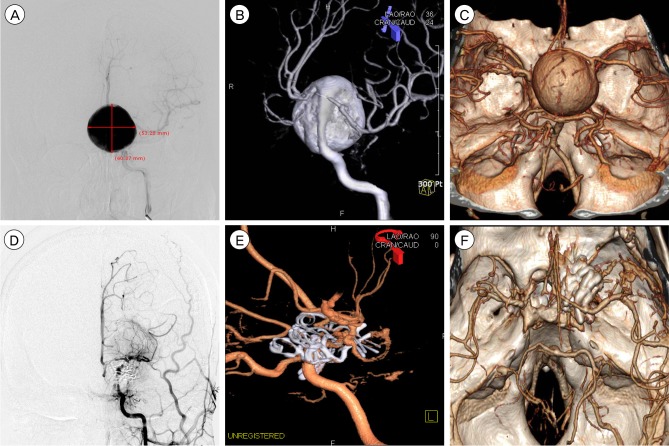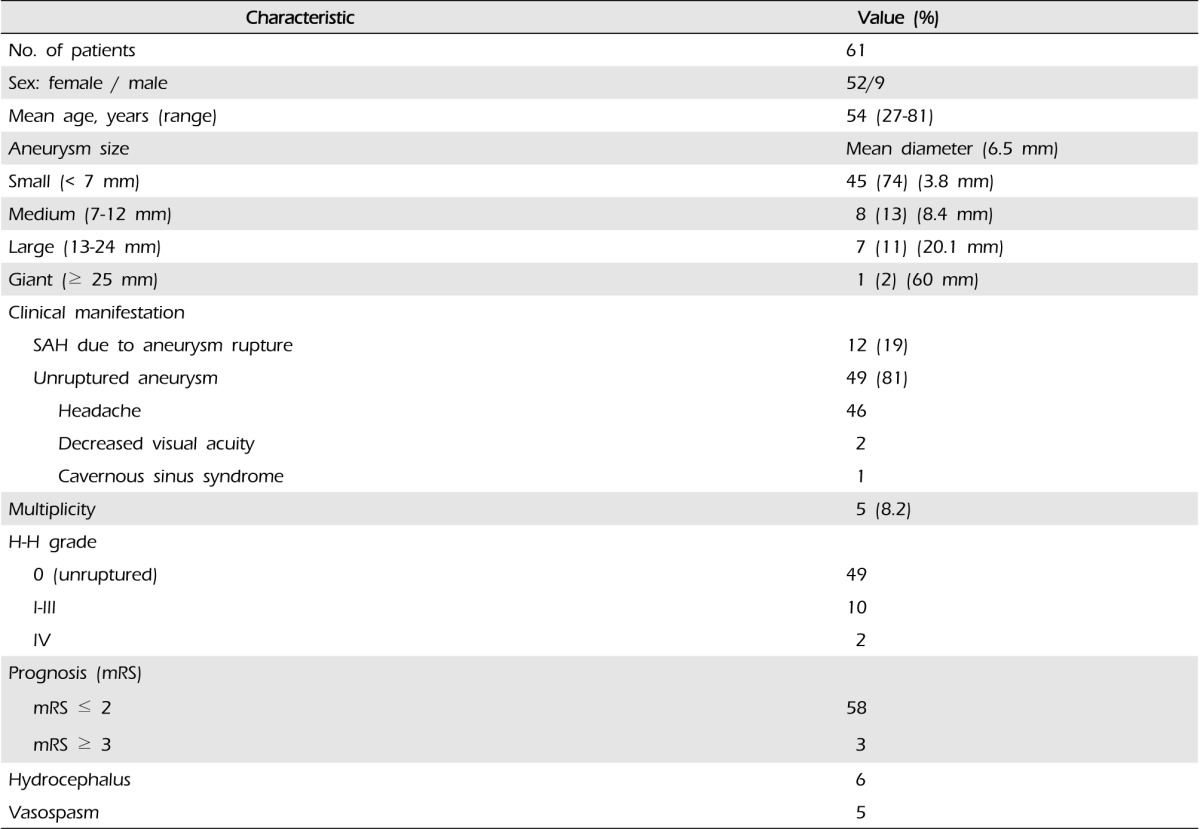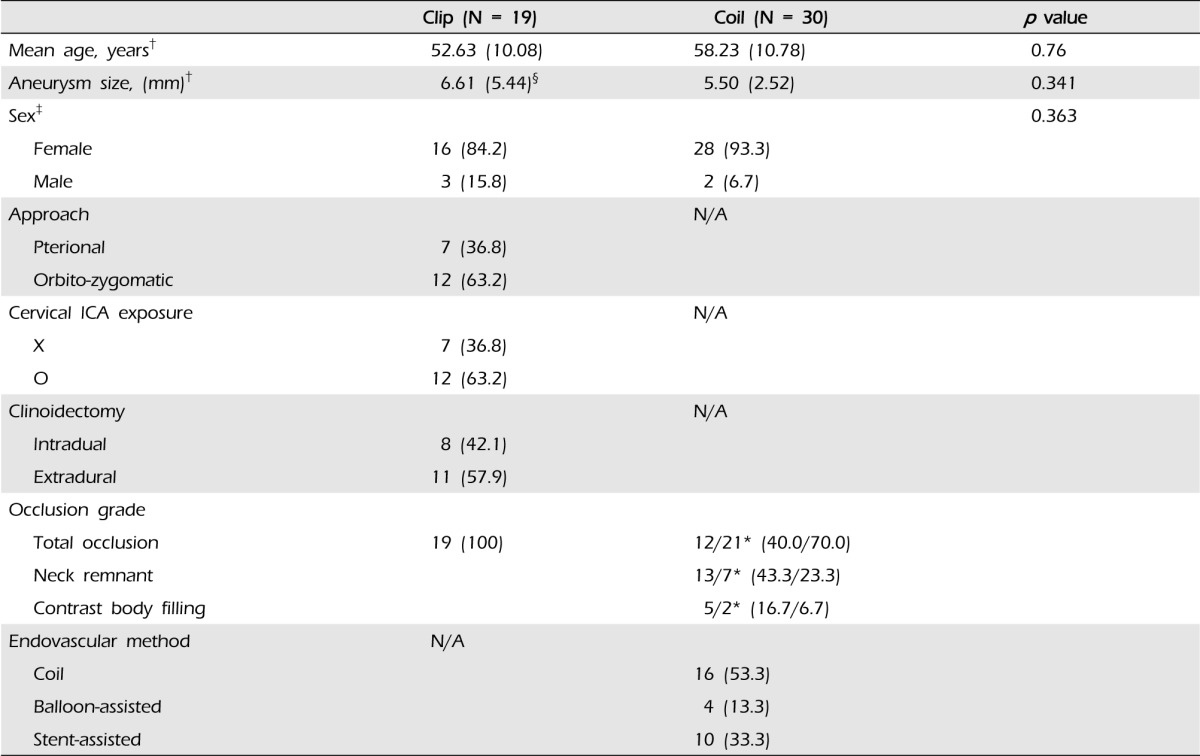1. Arnautovic KI, Al-Mefty O, Angtuaco E. A combined microsurgical skull-base and endovascular approach to giant and large paraclinoid aneurysms. Surg Neurol. 1998; 12. 50(6):504–518. discussion 518-20. PMID:
9870810.
2. Barami K, Hernandez VS, Diaz FG, Guthikonda M. Paraclinoid carotid aneurysms: surgical management, complications, and outcome based on a new classification scheme. Skull base. 2003; 2. 13(1):31–41. PMID:
15912157.

3. Batjer HH, Kopitnik TA, Giller CA, Samson DS. Surgery for paraclinoid aneurysms. J Neurosurg. 1994; 4. 80(4):650–658. PMID:
8151343.
4. Beretta F, Andaluz N, Zuccarello M. Aneurysms of the ophthalmic (C6) segment of the internal carotid artery: treatment options and strategies based on a clinical series. J Neurosurg Sci. 2004; 12. 48(4):149–156. PMID:
15876983.
5. Colli BO, Carlotti CG Jr, Assirati JA Jr, Abud DG, Amato MC, Dezena RA. Results of microsurgical treatment of paraclinoid carotid aneurysms. Neurosurg Rev. 2013; 1. 36(1):99–114. PMID:
22898891.

6. De Jesus O, Sekhar LN, Riedel CJ. Clinoid and paraclinoid aneurysms: surgical anatomy, operative techniques, and outcome. Surg Neurol. 1999; 5. 51(5):477–487. discussion 487-8. PMID:
10321876.
7. Dolenc VV. A combined transorbital-transclinoid and transsylvian approach to carotid-ophthalmic aneurysms without retraction of the brain. Acta Neurochir Suppl. 1999; 72:89–97. PMID:
10337416.

8. Day AL. Aneurysms of the ophthalmic segment. A clinical and anatomical analysis. J Neurosurg. 1990; 5. 72(5):677–691. PMID:
2324793.
9. Eliava SS, Filatov YM, Yakovlev SB, Shekhtman OD, Kheireddin AS, Sazonov IA, et al. Results of microsurgical treatment of large and giant ICA aneurysms using the retrograde suction decompression (RSD) technique: series of 92 patients. World Neurosurg. 2010; 6. 73(6):683–687. PMID:
20934156.

10. Fernandez Zubillaga A, Guglielmi G, Vinuela F, Duckwiler GR. Endovascular occlusion of intracranial aneurysms with electrically detachable coils: correlation of aneurysm neck size and treatment results. AJNR Am J Neuroradiol. 1994; 5. 15(5):815–820. PMID:
8059647.
11. Ferrell AS, Lessne ML, Alexander MJ, Shah P, Golshani K, Zomorodi A, et al. Visual complications after stent-assisted endovascular embolization of paraophthalmic and suprasellar variant superior hypophyseal aneurysms: the Duke cerebrovascular center experience in 57 patients. World Neurosurg. 2012; Sep-Oct. 78(3-4):289–294. PMID:
22381310.

12. Fulkerson DH, Horner TG, Payner TD, Leipziq TJ, Scott JA, Denardo AJ, et al. Endovascular retrograde suction decompression as an adjunct to surgical treatment of ophthalmic aneurysms: analysis of risks and clinical outcomes. Neurosurgery. 2009; 3. 64(3 Suppl):ons107–ons111. discussion ons111-2. PMID:
19240558.

13. Giannotta SL. Ophthalmic segment aneurysm surgery. Neurosurgery. 2002; 3. 50(3):558–562. PMID:
11841724.

14. Heran NS, Song JK, Kupersmith MJ, Niimi Y, Namba K, Langer DJ, et al. Large ophthalmic segment aneurysms with anterior optic pathway compression: assessment of anatomical and visual outcomes after endovascular coil therapy. J Neurosurg. 2007; 6. 106(6):968–975. PMID:
17564166.
15. Hoh BL, Carter BS, Budzik RF, Putman CM, Ogilvy CS. Results after surgical and endovascular treatment of paraclinoid aneurysms by a combined neurovascular team. Neurosurgery. 2001; 1. 48(1):78–90. discussion 89-90. PMID:
11152364.

16. Iihara K, Murao K, Sakai N, Shindo A, Sakai H, Higashi T, et al. Unruptured paraclinoid aneurysms: a management strategy. J Neurosurg. 2003; 8. 99(2):241–247. PMID:
12924695.

17. Jin SC, Kwon DH, Ahn JS, Kwun BD, Song Y, Choi CG. Clinical and radiological outcomes of endovascular detachable coil embolization in paraclinoid aneurysms: a 10-year experience. J Korean Neurosurg Soc. 2009; 1. 45(1):5–10. PMID:
19242564.
18. Khan N, Yoshimura S, Roth P, Cesnulis E, Koenue-Leblebicioglu D, Curcic M, et al. Conventional microsurgical treatment of paraclinoid aneurysms: state of the art with the use of the selective extradural anterior clinoidectomy SEAC. Acta Neurochir Suppl. 2005; 94:23–29. PMID:
16060237.

19. Kim JM, Romano A, Sanan A, van Loveren HR, Keller JT. Microsurgical anatomic features and nomenclature of the paraclinoid region. Neurosurgery. 2000; 3. 46(3):670–680. discussion 680-2. PMID:
10719864.

20. Kolasa PP, Kaurzel Z, Lewinski A. Treatment of giant paraclinoid aneurysms. Own experience. Neuro Endocrinol Lett. 2004; 8. 25(4):287–291. PMID:
15361819.
21. Kwon BJ, Im SH, Park JC, Cho YD, Kang HS, Kim JE, et al. Shaping and navigating methods of microcatheters for endovascular treatment of paraclinoid aneurysms. Neurosurgery. 2010; 7. 67(1):34–40. discussion 40. PMID:
20559090.

22. Liu Y, You C, He M, Cai BW. Microneurosurgical management of the clinoid and paraclinoid aneurysms. Neurol Res. 2008; 7. 30(6):552–556. PMID:
18647492.

23. Loumiotis I, D'Urso PI, Tawk R, Cloft HJ, Kallmes DF, Kairouz V, et al. Endovascular treatment of ruptured paraclinoid aneurysms: results, complications, and follow-up. AJNR Am J Neuroradiol. 2012; 4. 33(4):632–637. PMID:
22173755.

24. Morgan MK, Efkhar B. Commentary: paraclinoid carotid aneurysms. J Clin Neurosci. 2011; 1. 18(1):23. PMID:
20970345.

25. Nutik S. Carotid paraclinoid aneurysms with intradural origin and intracavernous location. J Neurosurg. 1978; 4. 48(4):526–533. PMID:
632877.

26. Nutik SL. Removal of the anterior clinoid process for exposure of the proximal intracranial carotid artery. J Neurosurg. 1988; 10. 69(4):529–534. PMID:
3418385.

27. Ogilvy CS. Paraclinoid carotid aneurysms. In : Ojemann RG, Ogilvy CS, Crowell RM, Heros RC, editors. Surgical management of neurovascular disease. 3rd ed. Baltimore: Williams & Wilkins;1995. p. 185–213.
28. Raco A, Frati A, Santoro A, Vangelista T, Salvati M, Delfini R, et al. Long-term surgical results with aneurysms involving the ophthalmic segment of the carotid artery. J Neurosurg. 2008; 6. 108(6):1200–1210. PMID:
18518728.

29. Raymond J, Guilbert F, Weill A, Georganos SA, Juravsky L, Lambert A, et al. Long-term angiographic recurrences after selective endovascular treatment of aneurysms with detachable coils. Stroke. 2003; 6. 34(6):1398–1403. PMID:
12775880.

30. Park HK, Horowitz M, Jungreis C, Kassam A, Koebbe C, Genevro J, et al. Endovascular treatment of paraclinoid aneurysms: experience with 73 patients. Neurosurgery. 2003; 7. 53(1):14–23. discussion 24. PMID:
12823869.

31. Roy D, Milot G, Raymond J. Endovascular treatment of unruptured aneurysms. Stroke. 2001; 9. 32(9):1998–2004. PMID:
11546888.

32. Roy D, Raymond J, Bouthillier A, Bojanowski MW, Moumdjian R, L'Esperance G. Endovascular treatment of ophthalmic segment aneurysms with Guglielmi detachable coils. AJNR Am J Neuroradiol. 1997; 8. 18(7):1207–1215. PMID:
9282843.

33. Thornton J, Aletich VA, Debrun GM, Alazzaz A, Misra M, Charbel F, et al. Endovascular treatment of paraclinoid aneurysms. Surg Neurol. 2000; 10. 54(4):288–299. PMID:
11136984.

34. Xu BN, Sun ZH, Romani R, Jiang JL, Wu C, Zhou DB, et al. Microsurgical management of large and giant paraclinoid aneurysms. World Neurosurg. 2010; 3. 73(3):137–146. discussion e17, e19. PMID:
20860951.

35. Yadla S, Campbell PG, Grobelny B, Jallo J, Gonzalez LF, Rosenwasser RH, et al. Open and endovascular treatment of unruptured carotid-ophthalmic aneurysms: clinical and radiographic outcomes. Neurosurgery. 2011; 5. 68(5):1434–1443. discussion 1443. PMID:
21273934.

36. Zhao J, Wang S, Zhao Y, Sui D, Zhang Y, Tang J, et al. Microneurosurgical management of carotid-ophthalmic aneurysms. J Clin Neurosci. 2006; 4. 13(3):330–333. PMID:
16546392.







 PDF
PDF ePub
ePub Citation
Citation Print
Print






 XML Download
XML Download